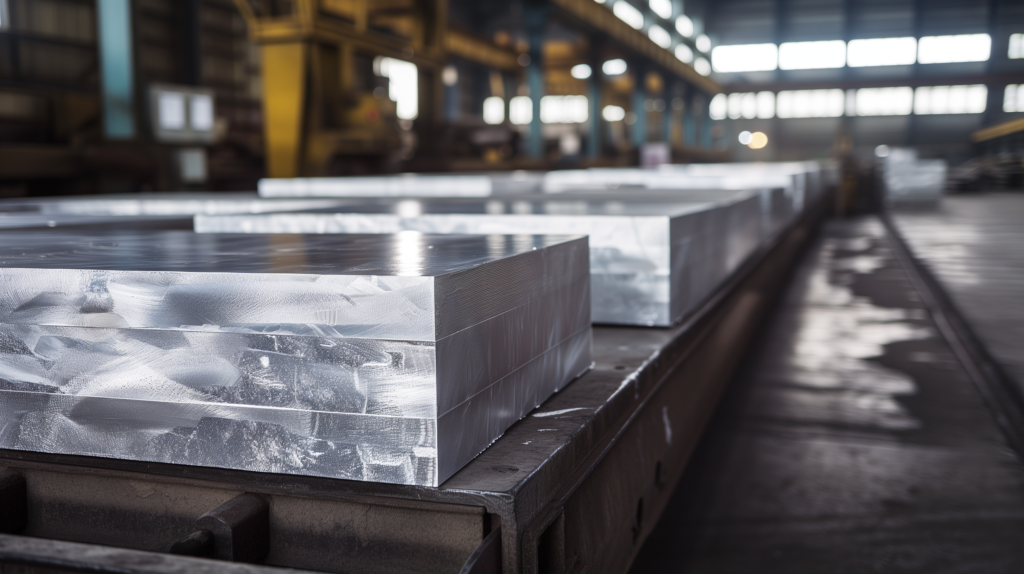The Commodity of the Decade
Aluminum is a $170 billion market and one of the commodities expected to experience significant growth in this decade. It is the most abundant metal on Earth, constituting 8% of the Earth’s crust by weight, and possesses properties that make it one of the most important metals for modern industry.
Today, anyone can trade aluminum from the comfort of their own home, as long as they have an internet connection.
In this article, you will learn everything about this commodity and how you can profit from aluminum.
Bauxite, Alumina, and Aluminum
Aluminum does not occur naturally in its pure state; it must be extracted from bauxite, an ore in which aluminum is bound to oxygen. Every 5 kg of bauxite produce 2 kg of alumina in the refinery, which generates 1 kg of aluminum in the smelter, these are the three stages of this metal’s chain.
The price of aluminum per kilogram was $1,200 until 1886, more expensive than gold, and was only used in cutlery and brooches by the nobility. Until that year, a 23-year-old American and a Frenchman independently discovered how to electrolyze bauxite, which reduced the price of aluminum from $1,200 per kilogram to $1 per kilogram in a few years.
Industry and Recycling
This unleashed the full potential of aluminum for industry, as it is a lightweight, malleable, and temperature-resistant metal ranging from -80 to +300°C. Today, one-third of the aluminum used in the world is secondary, coming from recycling, and it can be recycled indefinitely, with 75% of the aluminum ever produced still in use. Recycling uses only 5% of the energy compared to primary extraction, making it a fundamental material for a sustainable economy.
Brazil is one of the countries that recycles the most aluminum; in 2022, 390,000 tons were recycled, the same amount as the country’s primary production.

The 4 Consumers of Aluminum
The industries that consume the most aluminum are, in this order: transportation, construction, electronics, and packaging. It has been increasingly used in vehicles and airplanes instead of steel due to its lightness, in parts such as radiators, wheels, bumpers, suspension, hood, doors, with the weight of a vehicle reduced by 1 kg for every kilogram of aluminum used.
In construction, aluminum is the second most used metal, in structures such as windows, curtains, roofs, handrails, and stairs. In electronics, it is also ubiquitous: it is in smartphones, tablets, laptops, flat-screen TVs, and monitors, and the 4th largest industry that uses it, and perhaps the most well-known, is packaging: aluminum foil, beer and soda cans, and packaging in general, where aluminum has been replacing plastic because it is recyclable and does not come from fossil fuels.
Therefore, this is one of the commodities that is expected to grow the most by 2030, more than 6% per year, with the largest consumers being in China, the United States, India, Japan, and Germany, and the largest producers being China, Russia, Canada, Australia, and Norway.
Investing in Aluminum
For those investing in aluminum, the main risks include dependence on raw materials, bauxite, regulations, geopolitical tensions, and competition from alternative materials. Monitoring these factors is crucial to gaining an advantage in the market, the longer the term of your investment, the better.
To invest in aluminum, we have 3 main options. This is not a recommendation for these assets, it’s just for you to learn about ways to profit from aluminum and do your own research on these assets.

Stocks in the Aluminum Sector
The first way is directly through stocks of companies that produce aluminum. The most traditional ones in the sector are Alcoa (AA), one of the largest bauxite miners in the world, which also operates alumina refineries.
Another is Rio Tinto (RIO), the 2nd largest mining group in the world, but only 9% of its revenue comes from aluminum, 3/4 comes from iron ore, but it still has 5 bauxite mines, 4 alumina refineries, and 14 aluminum smelters. A company more focused on aluminum is Century Aluminum (CENX), with 3 smelters in the United States and one in Iceland.
Aluminum ETFs
The second way to expose yourself to this metal is through ETFs, exchange-traded funds, where you can expose yourself to the basic materials sector as a whole, with IYM, an ETF from the iShares series by BlackRock that brings together stocks of American companies in basic commodities, such as metals, paper, and chemicals.
DBB is another ETF, from Invesco, which brings together 3 basic metals for the industry: aluminum, zinc, and copper, practically 1/3 exposure to each, or XME, which replicates the S&P 500 metals index, including coal, metals, and steel. About 11% of it is aluminum. This is to expose yourself to an index, not to companies in the sector.
Aluminum Derivatives
The third way is by directly trading the price of aluminum through some derivative, but always obeying the regulation of your country, nothing in this video is a recommendation.
Of course, there are other ways to invest, through futures contracts, which the aluminum industry uses to hedge itself, and reflect the price of the material, or through options, which have their own rules, so choose the most appropriate instrument for you.
In this video, I analyze the price chart of aluminum:
>> See also:
